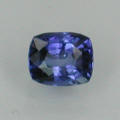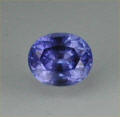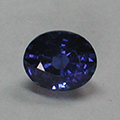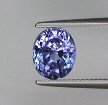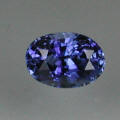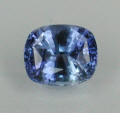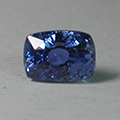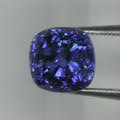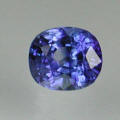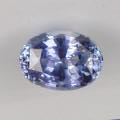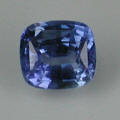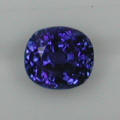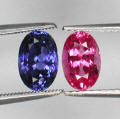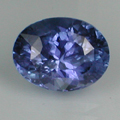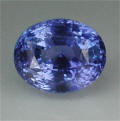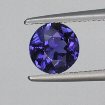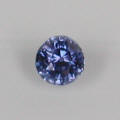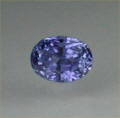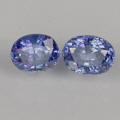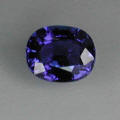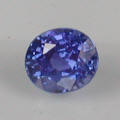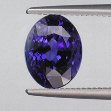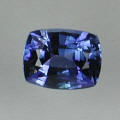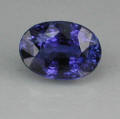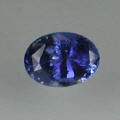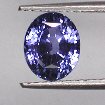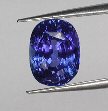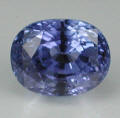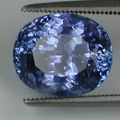|
Sapphire and Ruby comprise more than half of all Gemstones sold worldwide. Sapphire's popularity is not based on color alone. Its hardness of 9 places it next to Diamond (10), making it an excellent choice for jewelry worn daily. Blue Sapphire is frequently featured on engagement rings. Most people relate Sapphire to the color Blue. Sapphire is in the Corundum (ko-RUN-dum) mineral family. Although everyone has heard of the fabled Burmese Kashmir Sapphire, few have ever seen one. We constantly see appraisals that refer to Kashmir Sapphire (or Cashmere Sapphire), but it is usually referring to a Top Gem Ceylon Sapphire from Sri Lanka. The term Kashmir is widely regarded to mean the finest quality Blue Sapphire with a velvety, slightly violetish blue, highly saturated in medium to medium dark tone, with sleepy transparency. Once in a great while we are able to acquire one from Burma, but since the mine has been depleted and these highly prized stones are old stones that are simply brought back onto the market, they don't last long. Authentic Kashmir Sapphires and the Kashmir color Sapphires carry a particularly high cost per carat and are very highly valued Collectors Gemstones.
There are an array of color grades, and prices, and sometimes it's difficult to know what quality of color to expect in stones at various prices.
The Blue Sapphire color next on the popularity scale is Cornflower Blue. The Cornflower Blue or Medium Blue color shades vary but all usually allow more light into the stone for a brighter appearance, so these stones are usually cut in the Cushion or Oval shape to make it as brilliant as possible. Price per carat reflects the size, evenness of the color, the clarity and the brightness of the stone.
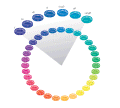 We prefer to use the GIA Colored Stone Grading System, this is an exceptionally good method for noting the quality of color stones. In commercial grade Blue Sapphire you can expect to see the hue range from violet (V) to a very strongly greenish blue (vstgB), and tones will range between 2 and through 8, but less of a saturation range. We prefer to use the GIA Colored Stone Grading System, this is an exceptionally good method for noting the quality of color stones. In commercial grade Blue Sapphire you can expect to see the hue range from violet (V) to a very strongly greenish blue (vstgB), and tones will range between 2 and through 8, but less of a saturation range.  Saturation in the commercial grade is usually from 1 to 3. Gem Quality Blue Sapphire usually narrow in the range of hues. The hues usually range from violet (V) to a very slightly greenish blue (vslgB), and their ranges of tone can be somewhere between 3 and 7, but optimum choice is between 4 to 6. Saturation in the Gem Quality grade can be from 3 through 5, but again the optimum is 4 to 5. In Top Gem Quality Blue Sapphire the hues can range from a bluish-violet, or violetish-blue, or pure blue (bV, vB, or B). Tone should be between 5 and 7, and saturation should be 5 or 6. The examples in the diagram are bV 5/5 to 7/5, vB 5/5 to 7/5, and B 5/5 to 7/5, and B 6/6. Saturation in the commercial grade is usually from 1 to 3. Gem Quality Blue Sapphire usually narrow in the range of hues. The hues usually range from violet (V) to a very slightly greenish blue (vslgB), and their ranges of tone can be somewhere between 3 and 7, but optimum choice is between 4 to 6. Saturation in the Gem Quality grade can be from 3 through 5, but again the optimum is 4 to 5. In Top Gem Quality Blue Sapphire the hues can range from a bluish-violet, or violetish-blue, or pure blue (bV, vB, or B). Tone should be between 5 and 7, and saturation should be 5 or 6. The examples in the diagram are bV 5/5 to 7/5, vB 5/5 to 7/5, and B 5/5 to 7/5, and B 6/6.
TREATMENTS - Almost all (99%) Sapphire on the market is routinely treated with 'heat' to enhance and stabilize the color. The typical heat treatment process is a permanent process and it does not normally adversely affect the performance, and durability of the gem, but in recent years demand for natural non-heated non-treated top quality Sapphire has caused these gems to command a somewhat higher premium, depending on the gem. When we disclose a gem as enhanced with 'heat', we are typically referring to the heat enhancement procedure performed in Sri Lanka right near the mines, using the lower temperature wood heat method. This 'blow' heat method typically is used on very very good quality Ceylon gems, only to slightly enhance the color and/or to stabilize the color from fading in sunlight. There's no need to worry when you see this enhancement disclosed. Almost all Ceylon Padparadscha Sapphire and virtually all Ceylon Orange Sapphire on the market was subjected to 'blow' heat. This 'blow' heating method has been an accepted trade practice for many many generations. There are other types of heat enhancement procedures, however, one of which is a high temperature furnace fired method. This 'furnace' process is typically performed on Sapphire of a much lesser quality. The goal is to seriously enhance or alter the color and/or clarity of the stone. Most of these gemstones are highly heated, almost to the melting point of the gem, so it is 'cooked' over and over until the gem dealers feel it is a more desirable color and will fetch a better price in the market. We normally do not offer gemstones that have been highly heated.
CAVEAT EMPTOR - A new type heat enhancement was introduced recently, called 'bulk diffusion', which means the gem is subjected to the high temperature furnace fired method above 1900o C, and also under high pressure, then a coloring agent is added to the mix to alter and/or change the color of the gemstone. AGTA and GIA gem labs, after examination of this 'bulk diffused' heat treatment process reveals that the color does not go all the way through the gem, but is only in the outer layer, so if the stone is ever scratched or recut the outside color layer would be removed and the original color would then be visible under the outer layer of the gem. These 'bulk diffusion' factories are usually at locations in Thailand, and since Asian gem suppliers (and there are many online now) are not subject to the same disclosure laws as we are here in the US, these enhancement processes are rarely disclosed to the buyer, so buyers please beware. For example, you may see a premium Ceylon Sapphire advertised on one of those websites for what appears to be pennies on the dollar. You can rest assured this is most likely a diffused stone altered by one of the Asian factories. Some of these gem suppliers even go to great lengths to try to convince the public that there is no difference in the value of their diffused gems, and the value of a natural non-treated gem, but any experienced jeweler will verify that a statement like that is totally untrue. We specialize in obtaining top quality Ceylon Sapphires that are natural "non-treated" gems, not heated or chemically treated in any way (the exception is Padparadscha, Golden, Orange, and some of the darker shades of Blue Sapphire, which as stated in treatments above are typically 'blow' heat enhanced to stabilize the color.
CARE - It is usually safe to clean Sapphire in an UltraSonic Cleaner, and generally safe to use a steamer. The best practice is to use an Ionic Cleaner and/or warm soapy water and a soft brush as the best way to clean your Sapphire Jewelry.
|



 Contact
Contact

